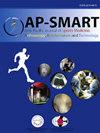Fast rehabilitation does not worsen clinical, radiological, and arthroscopic outcomes after medial meniscus posterior root repair: A retrospective comparative study
IF 1.4
Q3 ORTHOPEDICS
Asia-Pacific Journal of Sport Medicine Arthroscopy Rehabilitation and Technology
Pub Date : 2024-09-23
DOI:10.1016/j.asmart.2024.09.003
引用次数: 0
Abstract
Background/Objective
The main surgical treatment for medial meniscus posterior root tear (MMPRT) has shifted from meniscectomy to meniscus repair; however, there is no clear consensus regarding the optimal postoperative management strategy after MMPRT repair. This study aimed to perform a comparative analysis of patients who received conventional rehabilitation or fast rehabilitation following MMPRT repair.
Methods
The current retrospective cohort study compared clinical, radiological, and arthroscopic outcomes after conventional rehabilitation (group A, January 2020 to April 2020, 24 patients) with those after fast rehabilitation (group B, May 2020 to August 2020, 24 patients) in patients who underwent pullout repair for MMPRT. Partial weight-bearing and range of motion exercises were allowed 2 weeks postoperatively in group A and 1 week postoperatively in group B. In patients with an average weight of approximately 60 kg, full weight bearing was allowed 4 weeks postoperatively in group A and 3 weeks postoperatively in group B.
Results
At 12 months postoperatively, the clinical scores, including International Knee Documentation Committee and Japanese Knee Injury and Osteoarthritis Outcome Score, significantly improved in both groups (p < 0.01). Although meniscus healing was achieved in both groups, medial meniscus extrusion significantly progressed by 0.9 mm in group A and 0.8 mm in group B (p < 0.01, compared with preoperative extrusion). There were no significant differences in clinical scores, arthroscopic meniscal healing status, or medial meniscus extrusion progression on magnetic resonance images between the groups.
Conclusion
A fast rehabilitation protocol can be safely implemented without compromising patient outcomes after pullout repair for MMPRT.
快速康复不会恶化内侧半月板后根修补术后的临床、放射学和关节镜结果:回顾性比较研究
背景/目的内侧半月板后根撕裂(MMPRT)的主要手术治疗方法已从半月板切除术转变为半月板修复术;然而,关于 MMPRT 修复术后的最佳管理策略,目前尚无明确共识。本研究旨在对 MMPRT 修复术后接受常规康复治疗或快速康复治疗的患者进行比较分析。方法本回顾性队列研究比较了接受牵拉修复术的 MMPRT 患者在常规康复治疗(A 组,2020 年 1 月至 2020 年 4 月,24 名患者)和快速康复治疗(B 组,2020 年 5 月至 2020 年 8 月,24 名患者)后的临床、放射学和关节镜结果。结果术后12个月,两组患者的临床评分(包括国际膝关节文献委员会和日本膝关节损伤和骨关节炎结果评分)均明显改善(p <0.01)。虽然两组患者的半月板都已愈合,但与术前相比,A 组的内侧半月板挤压明显增加了 0.9 毫米,B 组增加了 0.8 毫米(p < 0.01)。两组患者的临床评分、关节镜下半月板愈合情况或磁共振图像上的内侧半月板挤压进展无明显差异。
本文章由计算机程序翻译,如有差异,请以英文原文为准。
求助全文
约1分钟内获得全文
求助全文
来源期刊
CiteScore
3.80
自引率
0.00%
发文量
21
审稿时长
98 days
期刊介绍:
The Asia-Pacific Journal of Sports Medicine, Arthroscopy, Rehabilitation and Technology (AP-SMART) is the official peer-reviewed, open access journal of the Asia-Pacific Knee, Arthroscopy and Sports Medicine Society (APKASS) and the Japanese Orthopaedic Society of Knee, Arthroscopy and Sports Medicine (JOSKAS). It is published quarterly, in January, April, July and October, by Elsevier. The mission of AP-SMART is to inspire clinicians, practitioners, scientists and engineers to work towards a common goal to improve quality of life in the international community. The Journal publishes original research, reviews, editorials, perspectives, and letters to the Editor. Multidisciplinary research with collaboration amongst clinicians and scientists from different disciplines will be the trend in the coming decades. AP-SMART provides a platform for the exchange of new clinical and scientific information in the most precise and expeditious way to achieve timely dissemination of information and cross-fertilization of ideas.

 求助内容:
求助内容: 应助结果提醒方式:
应助结果提醒方式:


